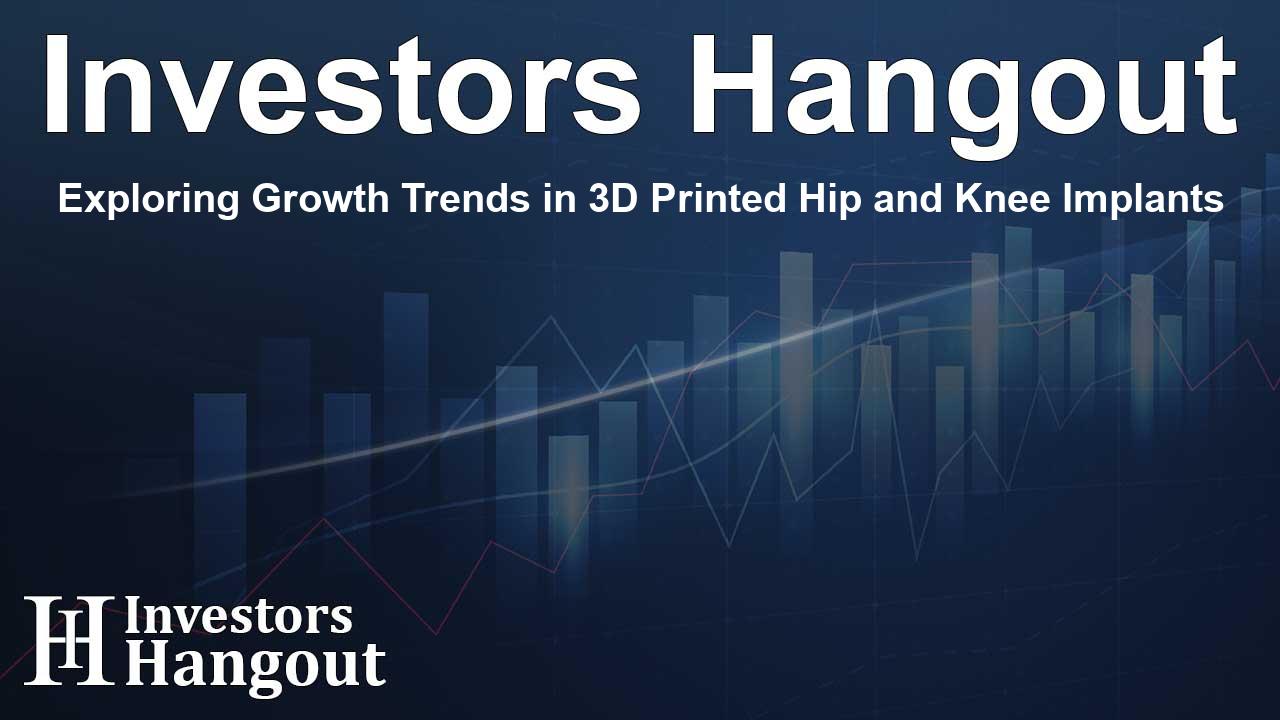Exploring Growth Trends in 3D Printed Hip and Knee Implants

Growth of the 3D Printed Hip and Knee Implants Market
The global 3D printed hip and knee implants market has shown remarkable expansion, valued at approximately USD 5.81 billion. Projections suggest that this figure could soar to around USD 28.87 billion by the year 2034, demonstrating a robust compound annual growth rate (CAGR) of 17.49%. This significant increase in market size can be attributed to several factors, including the growing elderly population and a rising demand for advanced medical technology.
Key Drivers of Market Growth
Among the primary forces propelling this market's growth is the increasing incidence of joint diseases. For instance, conditions like osteoarthritis are becoming more prevalent, particularly in older adults, leading to a heightened need for joint replacement surgeries. Furthermore, technological innovations in 3D printing are enabling the creation of customized implants that are tailored to individual anatomy, improving both fit and functionality. These tailored solutions not only enhance surgical outcomes but also boost patient satisfaction, thus fostering an expanding market.
Technological Innovations
One of the most exciting developments in the 3D printed implants sector is the adoption of patient-specific designs, which are created based on detailed 3D scans. This allows for a deviation from traditionally manufactured implants, which often lack proper fitting. Additionally, advancements in materials, such as the use of biocompatible metals and polymers, are improving the safety and longevity of these implants.
Regional Insights and Market Segmentation
Market analysis indicates that North America has been a frontrunner in the 3D printed hip and knee implants arena, largely due to its established healthcare infrastructure and a high rate of technology adoption. Furthermore, the growing geriatric population in this region necessitates innovative solutions for joint replacements.
Emerging Markets
Asia-Pacific is identified as the fastest-growing region in this landscape. Countries like China and India are enhancing their healthcare systems with an influx of investment and increasing public awareness regarding personalized healthcare solutions. This burgeoning focus on customized implants is spurring the growth of the market in these regions.
Challenges Facing the Market
Despite the promising outlook, the 3D printed hip and knee implants market is not without its challenges. Significant barriers to entry include high production costs and complex regulatory requirements that can delay the availability of new solutions. Manufacturers are also contending with the intricacies of ensuring long-term durability and reliability of these advanced products.
Current Trends in the Industry
As the industry evolves, several trends are emerging that are likely to shape its future. One notable trend is the movement towards personalized medicine, which focuses on creating custom implants tailored to individual anatomy for improved performance. Additionally, the use of advanced materials, such as biodegradable polymers, is on the rise, showing promise in enhancing recovery and outcomes after surgeries.
Integration of New Technologies
The integration of smart technology into implants is gaining traction, allowing for real-time monitoring of a patient’s healing process. Innovations such as robotic-assisted surgery further enhance the precision of implant placement, leading to quicker recovery times and better overall results.
Looking Ahead
The future of the 3D printed hip and knee implants market looks bright, bolstered by continuous advancements in technology and increasing global health initiatives. As healthcare systems around the world continue to embrace innovative solutions, the demand for personalized, high-quality implants will likely rise, heralding a new era of orthopedic solutions.
Frequently Asked Questions
What is the projected growth rate for the 3D printed hip and knee implants market?
The market is anticipated to grow at a CAGR of 17.49%, reaching approximately USD 28.87 billion by 2034.
Why is there increasing demand for 3D printed implants?
The rising elderly population and higher instances of conditions such as osteoarthritis are driving the need for joint replacement surgeries, thereby increasing demand for personalized implants.
Which region currently leads the market?
North America is leading in market share, largely due to its advanced medical technology and healthcare infrastructure.
What are the main challenges facing manufacturers in this market?
Manufacturers face challenges related to high production costs, complex regulatory requirements, and the need for skilled personnel in design and manufacturing.
How is technology influencing the future of this market?
Technological advancements, including robotic-assisted surgery and the use of smart materials, are enhancing the precision and success rates of surgeries, shaping the future of 3D printed implants.
About The Author
Contact Olivia Taylor privately here. Or send an email with ATTN: Olivia Taylor as the subject to contact@investorshangout.com.
About Investors Hangout
Investors Hangout is a leading online stock forum for financial discussion and learning, offering a wide range of free tools and resources. It draws in traders of all levels, who exchange market knowledge, investigate trading tactics, and keep an eye on industry developments in real time. Featuring financial articles, stock message boards, quotes, charts, company profiles, and live news updates. Through cooperative learning and a wealth of informational resources, it helps users from novices creating their first portfolios to experts honing their techniques. Join Investors Hangout today: https://investorshangout.com/
The content of this article is based on factual, publicly available information and does not represent legal, financial, or investment advice. Investors Hangout does not offer financial advice, and the author is not a licensed financial advisor. Consult a qualified advisor before making any financial or investment decisions based on this article. This article should not be considered advice to purchase, sell, or hold any securities or other investments. If any of the material provided here is inaccurate, please contact us for corrections.
